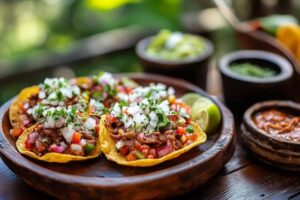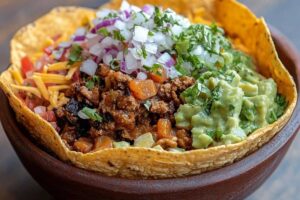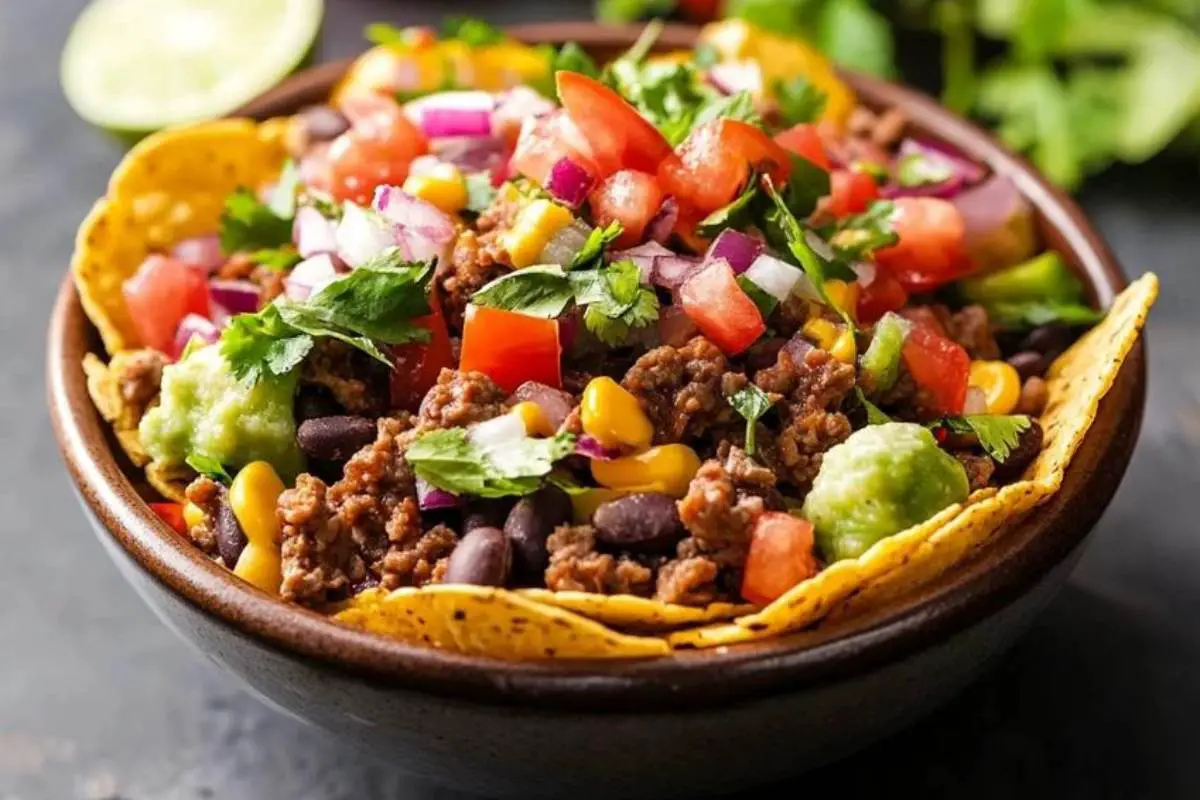Mexican food offers a variety of delicious dishes. Among these, tostadas and taco bowls stand out as popular choices. Although they share some ingredients, they differ in how they are prepared and served. Knowing the differences between them can help you decide which one to enjoy or make at home.
A tostada features a flat, crispy tortilla topped with various ingredients. In contrast, a taco bowl is a deconstructed taco, with ingredients layered in a bowl. If you’re curious about the background of iconic tacos, check out the History of Tacos Al Pastor.
Both dishes use similar ingredients, but they offer different eating experiences. A tostada provides a satisfying crunch, while a taco bowl offers more customization and a heartier meal. If you’re interested in healthy options, check out Healthy Pepper Recipes.
What Is a Tostada?
A tostada uses a flat, crispy tortilla as the base. It’s either fried or baked until it turns golden and crunchy. The word “tostada” comes from the Spanish word for “toasted.” Most tostadas use a corn tortilla, though flour tortillas can also work.
Once the tortilla is crispy, it’s topped with ingredients like refried beans, shredded meat, lettuce, avocado, and salsa. Because it’s served flat, the toppings sit on top, making it a little messier to eat than a taco.
Key Features of a Tostada:
- Crunchy base: Tostadas use tortillas that are fried or baked until crispy.
- Open-faced: Unlike tacos, tostadas are flat, allowing you to stack the ingredients on top.
- Common toppings: Popular toppings include refried beans, shredded chicken, lettuce, tomatoes, cheese, and salsa.
What Is a Taco Bowl?
A taco bowl offers a deconstructed taco, where the ingredients are served in a bowl. You’ll find similar ingredients to a taco, such as grilled meat, lettuce, beans, rice, and cheese. However, in a taco bowl, they are layered rather than wrapped in a tortilla.
Taco bowls became popular in Tex-Mex cuisine because they allow for flexibility in ingredients. You can create healthier versions by replacing rice with lettuce or using beans and vegetables instead of meat.
Key Features of a Taco Bowl:
How to Make Tostadas and Taco Bowls

Both dishes use similar ingredients but require different preparation methods. Here’s how to prepare each:
1. Making a Tostada:
You can fry or bake the tortilla to make it crispy.
Frying Tostadas:
- Heat oil in a pan over medium heat.
- Fry each tortilla until it turns golden brown, about 1-2 minutes per side.
- Drain the tortillas on paper towels to remove extra oil.
Baking Tostadas:
- Preheat the oven to 400°F.
- Lightly brush both sides of each tortilla with oil and place them on a baking sheet.
- Bake for 8-10 minutes, flipping halfway through, until crispy.
Once the tortilla is ready, add toppings like beans, shredded meat, and veggies.
2. Making a Taco Bowl:
A taco bowl involves layering the ingredients, though you can also create a crispy tortilla bowl.
Frying a Taco Bowl Shell:
- Heat oil in a deep pan.
- Place a large tortilla over an upside-down metal bowl in the oil to shape it.
- Fry until crispy and golden, then drain on paper towels.
Baking a Taco Bowl Shell:
- Preheat the oven to 375°F.
- Drape a large tortilla over an oven-safe bowl and bake for 8-10 minutes until crispy.
- Let it cool before filling it with rice, beans, meat, and vegetables.
For a lighter option, skip the tortilla shell and use lettuce as the base, layering grilled proteins, beans, and vegetables.
Key Differences Between a Tostada and a Taco Bowl
Though they share some ingredients, tostadas and taco bowls offer different presentations and textures.
1. Texture and Form:
- Tostada: Flat and crunchy, designed to hold fewer ingredients.
- Taco Bowl: Layered, offering both crunchy and soft textures.
2. Eating Experience:
- Tostada: Can be messy due to its open, flat base.
- Taco Bowl: Eaten with a fork, making it easier to control each bite.
3. Customization:
- Tostada: Offers less room for customization due to its limited surface.
- Taco Bowl: Allows for more ingredients and larger portions.
Nutritional Comparison: Tostada vs. Taco Bowl

Both tostadas and taco bowls are versatile dishes that can be tailored to meet a range of dietary needs. However, their nutritional content varies significantly depending on the preparation methods and ingredients used. Here’s a breakdown of the nutritional differences between the two:
Tostada: A Crunchy, Higher-Fat Option
Traditional tostadas are made by frying corn tortillas until they are golden and crispy. The toppings, often heavy on fried ingredients or rich sauces, can increase the calorie and fat content.
Key Nutritional Facts:
- Calories: A fried tostada typically contains about 200-300 calories, depending on the size of the tortilla and the toppings.
- Fat: Since tostadas are usually fried, they contain a higher amount of fat—especially if topped with sour cream, cheese, or fried meat. A fried tostada can have around 10-15 grams of fat.
- Carbohydrates: The base of the tostada is a corn tortilla, which adds around 20-25 grams of carbs.
- Protein: Depending on the toppings, tostadas can provide 7-15 grams of protein. Adding grilled chicken, beef, or beans increases protein levels.
- Fiber: A tostada with beans and vegetables offers around 4-6 grams of fiber, aiding in digestion.
How to Make a Tostada Healthier:
- Opt for baked tortillas instead of fried ones to reduce the fat content.
- Use lean proteins like grilled chicken or fish instead of fried meats.
- Add plenty of vegetables like lettuce, tomatoes, and avocado for extra nutrients and fiber.
- Limit or skip high-fat toppings like sour cream and excessive cheese.
Taco Bowl: A Healthier, More Customizable Option
Taco bowls are often seen as a healthier alternative to traditional Mexican dishes. Unlike tostadas, taco bowls can be tailored to meet various dietary preferences, from low-carb to high-protein. The ingredients in taco bowls tend to be more diverse and can include a balanced mix of proteins, carbs, and healthy fats.
Key Nutritional Facts:
- Calories: A typical taco bowl ranges from 400-600 calories, but this depends on the ingredients. A bowl with lean proteins, rice, and veggies will be lower in calories compared to one with fatty meats and cheese.
- Fat: Taco bowls can be relatively low in fat, especially if you opt for grilled proteins and limit high-fat toppings. On average, a taco bowl has around 10-20 grams of fat.
- Carbohydrates: Using rice as the base contributes around 30-50 grams of carbs, but you can reduce this by replacing rice with lettuce or using a smaller portion of rice.
- Protein: A taco bowl with grilled chicken, beef, or beans typically provides 20-30 grams of protein, making it a filling and nutritious option.
- Fiber: The inclusion of beans, lettuce, and other vegetables boosts the fiber content, offering around 6-8 grams of fiber.
How to Make a Taco Bowl Healthier:
- Use lettuce or a mix of greens as the base instead of rice to reduce carbs and calories.
- Choose grilled proteins like chicken, shrimp, or beans for a leaner, high-protein option.
- Add a variety of fresh vegetables to increase the nutrient and fiber content.
- Use Greek yogurt instead of sour cream for a lower-fat, higher-protein topping.
Final Nutritional Takeaway
Tostadas often contain more fat and calories due to frying, but can be lightened up by baking the tortillas and using leaner toppings. On the other hand, taco bowls provide more flexibility for creating a balanced, healthy meal by offering a mix of ingredients that can easily be adjusted to meet your nutritional goals. For those looking to cut back on calories or carbs, a taco bowl with fresh veggies and grilled proteins is often the healthier choice.
FAQs
What’s the difference between a taco and a tostada?
A taco is folded, while a tostada is flat and crispy, served with toppings piled on top.
Are taco bowls healthier than tostadas?
Taco bowls often offer healthier options because you can choose lighter ingredients, like grilled meats and fresh vegetables, while tostadas are usually fried.
Can I make a taco bowl with a tostada?
Yes! You can use a crispy tostada as the base and add taco bowl ingredients on top for a crunchy twist.

Conclusion
Tostadas and taco bowls provide flavorful ways to enjoy Mexican cuisine, but they offer different eating experiences. A tostada delivers a satisfying crunch, while a taco bowl allows for more ingredients and customization. Whether you prefer the crispiness of a tostada or the variety of a taco bowl, both can be easily adapted to your taste and dietary needs.
By knowing the key differences between these two dishes, you can decide which one best fits your next meal. Try experimenting with different toppings and enjoy the endless possibilities!

